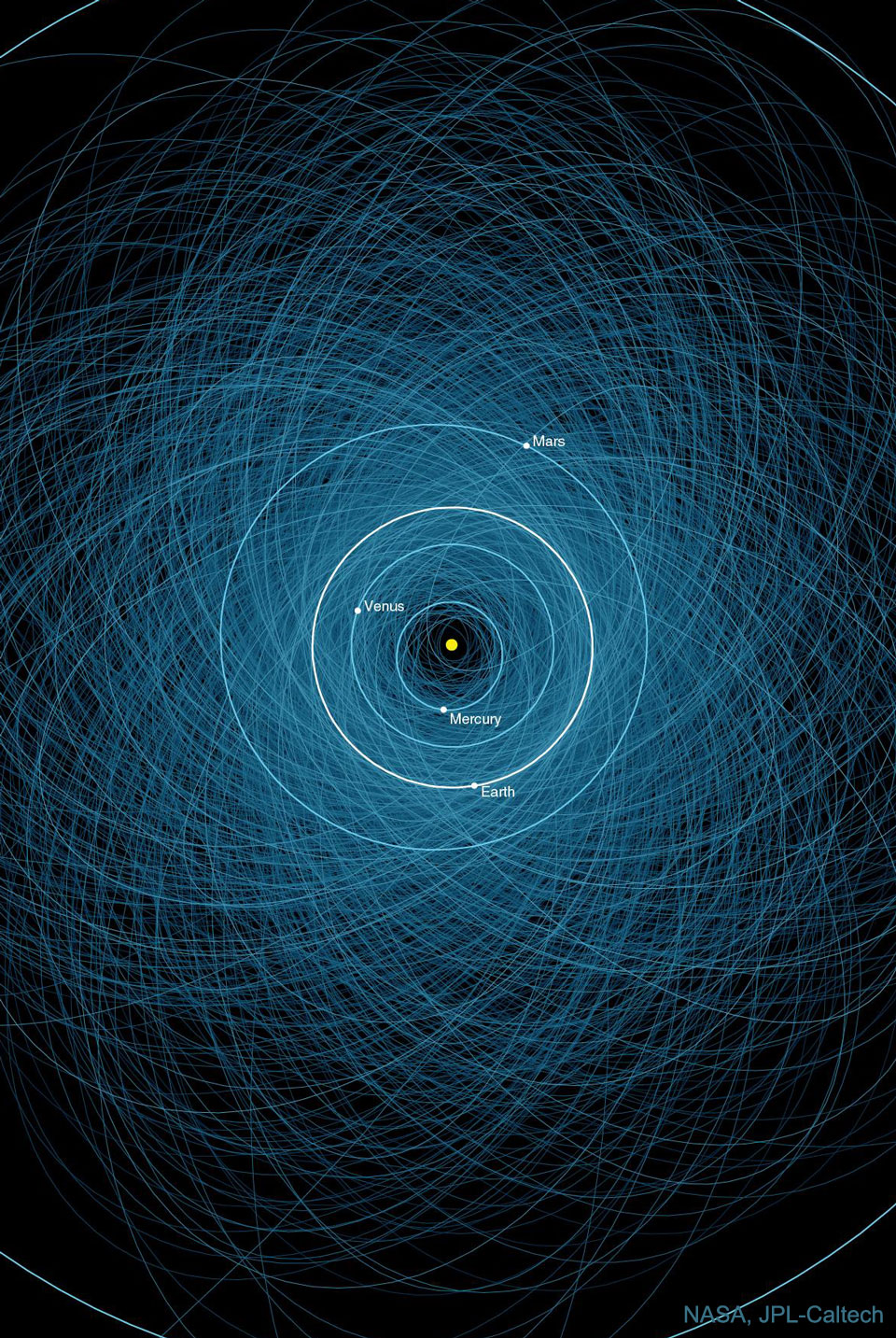30. June 2023
潛在威脅小行星 ê 軌道

探索宇宙1!逐工會揀一幅無仝款 ê 影像抑是相片,𤆬你熟似咱這个迷人 ê 宇宙,閣有專業天文學者2為你3解說4。
- 原始文章:Orbits of Potentially Hazardous Asteroids
- 插圖來源:NASA, JPL-Caltech
- 台文翻譯:An-Li Tsai (NCU)
[漢羅] 潛在威脅小行星 ê 軌道
小行星敢會危險? 有一寡會。 毋閣毋管是佗一年,大部份危險 ê 小行星挵著地球 ê 機會是足少 ê。 過去因為有發生一寡 kah 小行星挵著地球有關 ê 生物大滅絕事件,這馬人類已經 kā 這當做是一件真重要 ê 代誌:揣出 未來會影響 地球性命 ê 小行星,kā 編做目錄。 這張相片 是 1000 粒 潛在威脅 小行星 (PHAs) ê 軌道。 這寡資料有記錄著 超過 140 公尺闊、離地球 750 萬公里近(差不多是地球到月球 ê 20 倍距離)、leh 滾踅 ê 巨型 岩石 kah 冰角。 雖罔講 tī 紲落來 100 年猶袂有小行星 挵著地球,毋閣 毋是所有 PHAs 攏有揣著。 而且 tī 過去 100 年,足濟軌道嘛變做足歹預測 ê。 這款寸尺 ê 小行星若是 挵著地球,to̍h 會 引起足危險 ê chu-ná-mih。 為著欲揣出救地球 ê 辦法,NASA 舊年 ê 雙小行星改道實驗 (DART) 太空船 ê 實驗有成功完成任務。 是講較細粒 ê 石頭 kah 冰角 逐工攏會挵著地球,毋閣 in 無啥物危險,有當時仔閣會產生 難忘 ê 火流星 kah 流星表演。
[POJ] Chiâm-chāi-ui-hia̍p Sió-kiâⁿ-chhiⁿ ê Kúi-tō
Sió-kiâⁿ-chhiⁿ kám-ē ûi-hiám? Ū chi̍t-kóa ē. M̄-koh m̄-koán sī toh-chi̍t-nî, tōa-pō͘-hūn ûi-hiám ê sió-kiâⁿ-chhiⁿ lòng-tio̍h Tē-kiû ê ki-hōe sī chiok-chió ê. Kòe-khì in-ūi ū hoat-seng chi̍t-kóa kah sió-kiâⁿ-chhiⁿ lòng-tio̍h Tē-kiû ū-koan ê Seng-bu̍t tōa-bia̍t-choa̍t sū-kiāⁿ, chit-má jîn-lūi í-keng kā che tòng-chòe sī chi̍t-kiāⁿ chin tiōng-iàu ê tāi-chì: Chhōe-chhut bī-lâi ē éng-hióng Tē-kiû sìⁿ-miā ê sió-kiâⁿ-chhiⁿ, kā pian-chòe bo̍k-lo̍k. Chit-tiuⁿ siòng-phìⁿ sī chi̍t-chheng-lia̍p Chiâm-chāi-ui-hia̍p sió-kiâⁿ-chhiⁿ (PHAs) ê kúi-tō. Chit-kóa chu-liāu ū kì-lo̍k tio̍h chhiau-kòe chi̍t-pah-sì-cha̍p kong-chhioh khoah, lî Tē-kiû chhit-pah-gō͘-cha̍p-bān kong-lí kīn (chha-put-to sī Tē-kiû kàu Goe̍h-kiû ê jī-cha̍p pōe kū-lî), leh kún-se̍h ê kū-hêng giâm-chio̍h kah peng-kak. Sui-bóng-kóng tī sòa-lo̍h-lâi chi̍t-pah-nî iáu-bōe ū sió-kiâⁿ-chhiⁿ lòng-tio̍h Tē-kiû, m̄-koán m̄-sī só͘-ū PHAs lóng-ū chhōe-tio̍h. Jî-chhiáⁿ tī kòe-khì chi̍t-pah-nî, chiok-chōe kúi-tō mā piàn-chòe chiok phái ū-chhek ê. Chit-khoán chhùn-chhioh ê sió-kiâⁿ-chhiⁿ nā-sī lòng-tio̍h Tē-kiû, to̍h ē ín-khí chiok ûi-hiám ê chu-ná-mih. Ūi-tio̍h beh chhōe-chhut kiù Tē-kiû ê pān-hoat, NASA kū-nî ê Siang Sió-kiâⁿ-chhiⁿ Kái-tō Si̍t-giām (DART) thài-khong-chûn ê si̍t-giām ū sêng-kong oân-sêng jīm-bū. Sī-kóng khah sè-lia̍p ê chio̍h-thâu kah peng-kak ta̍k-kang lóng ē lòng-tio̍h Tē-kiû, m̄-koán in bô-siáⁿ-mih ûi-hiám, ū-tang-sî-á koh ē sán-seng lân-bōng ê hóe-liû-chhiⁿ kah liû-chhiⁿ piáu-ián.
[KIP] Tsiâm-tsāi-ui-hia̍p Sió-kiânn-tshinn ê Kuí-tō
Sió-kiânn-tshinn kám-ē uî-hiám? Ū tsi̍t-kuá ē. M̄-koh m̄-kuán sī toh-tsi̍t-nî, tuā-pōo-hūn uî-hiám ê sió-kiânn-tshinn lòng-tio̍h Tē-kiû ê ki-huē sī tsiok-tsió ê. Kuè-khì in-uī ū huat-sing tsi̍t-kuá kah sió-kiânn-tshinn lòng-tio̍h Tē-kiû ū-kuan ê Sing-bu̍t tuā-bia̍t-tsua̍t sū-kiānn, tsit-má jîn-luī í-king kā tse tòng-tsuè sī tsi̍t-kiānn tsin tiōng-iàu ê tāi-tsì: Tshuē-tshut bī-lâi ē íng-hióng Tē-kiû sìnn-miā ê sió-kiânn-tshinn, kā pian-tsuè bo̍k-lo̍k. Tsit-tiunn siòng-phìnn sī tsi̍t-tshing-lia̍p Tsiâm-tsāi-ui-hia̍p sió-kiânn-tshinn (PHAs) ê kuí-tō. Tsit-kuá tsu-liāu ū kì-lo̍k tio̍h tshiau-kuè tsi̍t-pah-sì-tsa̍p kong-tshioh khuah, lî Tē-kiû tshit-pah-gōo-tsa̍p-bān kong-lí kīn (tsha-put-to sī Tē-kiû kàu Gue̍h-kiû ê jī-tsa̍p puē kū-lî), leh kún-se̍h ê kū-hîng giâm-tsio̍h kah ping-kak. Sui-bóng-kóng tī suà-lo̍h-lâi tsi̍t-pah-nî iáu-buē ū sió-kiânn-tshinn lòng-tio̍h Tē-kiû, m̄-kuán m̄-sī sóo-ū PHAs lóng-ū tshuē-tio̍h. Jî-tshiánn tī kuè-khì tsi̍t-pah-nî, tsiok-tsuē kuí-tō mā piàn-tsuè tsiok phái ū-tshik ê. Tsit-khuán tshùn-tshioh ê sió-kiânn-tshinn nā-sī lòng-tio̍h Tē-kiû, to̍h ē ín-khí tsiok uî-hiám ê tsu-ná-mih. Uī-tio̍h beh tshuē-tshut kiù Tē-kiû ê pān-huat, NASA kū-nî ê Siang Sió-kiânn-tshinn Kái-tō Si̍t-giām (DART) thài-khong-tsûn ê si̍t-giām ū sîng-kong uân-sîng jīm-bū. Sī-kóng khah sè-lia̍p ê tsio̍h-thâu kah ping-kak ta̍k-kang lóng ē lòng-tio̍h Tē-kiû, m̄-kuán in bô-siánn-mih uî-hiám, ū-tang-sî-á koh ē sán-sing lân-bōng ê hué-liû-tshinn kah liû-tshinn piáu-ián.
[English] Orbits of Potentially Hazardous Asteroids
Are asteroids dangerous? Some are, but the likelihood of a dangerous asteroid striking the Earth during any given year is low. Because some past mass extinction events have been linked to asteroid impacts, however, humanity has made it a priority to find and catalog those asteroids that may one day affect life on Earth. Pictured here are the orbits of the over 1,000 known Potentially Hazardous Asteroids (PHAs). These documented tumbling boulders of rock and ice are over 140 meters across and will pass within 7.5 million kilometers of Earth -- about 20 times the distance to the Moon. Although none of them will strike the Earth in the next 100 years -- not all PHAs have been discovered, and past 100 years, many orbits become hard to predict. Were an asteroid of this size to impact the Earth, it could raise dangerous tsunamis, for example. To investigate Earth-saving strategies, NASA successfully tested the Double Asteroid Redirection Test (DART) mission last year. Of course, rocks and ice bits of much smaller size strike the Earth every day, usually pose no danger, and sometimes create memorable fireball and meteor displays.
詞彙學習
| 漢羅 | POJ | KIP | 華語 | English |
|---|---|---|---|---|
| 潛在威脅小行星 | chiâm-chāi-ui-hia̍p Sió-kiâⁿ-chhiⁿ | tsiâm-tsāi-ui-hia̍p Sió-kiânn-tshinn | 潛在威脅小行星 | Potentially Hazardous Asteroids (PHAs) |
| 生物大滅絕事件 | Seng-bu̍t tōa-bia̍t-choa̍t sū-kiāⁿ | Sing-bu̍t tuā-bia̍t-tsua̍t sū-kiānn | 生物大滅絕事件 | mass extinction event |
| 雙小行星改道實驗 | Siang Sió-kiâⁿ-chhiⁿ Kái-tō Si̍t-giām | Siang Sió-kiânn-tshinn Kái-tō Si̍t-giām | 雙小行星改道實驗 | Double Asteroid Redirection Test (DART) |
| chu-ná-mih | chu-ná-mih | tsu-ná-mih | 海嘯 | tsunami |
| 策略 | chhek-lio̍k | tshik-lio̍k | 策略 | strategy |
| 滾踅 | kún-se̍h | kún-se̍h | 滾動 | tumbling |